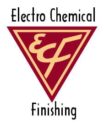Plating on Plastics
ECF has in-house capability to chrome plate a variety of plastic substrates. ABS (Acrylonitrile Butadiene Styrene) plastics have the highest volume usage for commercial plating applications. The chemistry of the resin lends itself favorably to the processing techniques used to obtain smooth, adherent metal deposits.
To plate on ABS and ABS/PC plastics, the substrate first undergoes a pre-plate process that essentially serves to metallize the plastic. First, the substrate is etched, creating bonding site for the metallic layer. The remaining etchant material is then neutralized, a film of palladium and tin is applied, and the tin is oxidized. Electroless nickel is then deposited on the part to metallize it and allow an electrical current to be introduced and maintained during electroplating. During the electroplating process, the component is plated first with acid copper, then various nickel composites, and finally chromium.
Metal Plating
ECF also has the capability to perform both decorative and functional plating on metal substrates. We perform gold, chrome, tin, nickel, and electroless nickel plating on metal substrates, which include steel, stainless steel, brass, aluminum, and more.
When performing decorative plating a metal substrate, the component first undergoes a process to condition and clean the component surface. The component is then subjected to plating baths where the desired metals are deposited on the component. For functional finishes, a component is cleaned, then subjected to passivation baths, which maximize the component’s resistance to corrosion.








